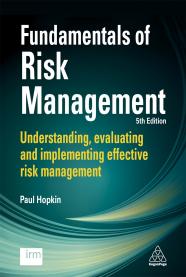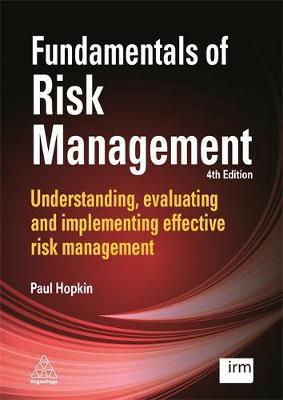Fundamentals of risk management
understanding, evaluating and implementing effective risk management
- ISBN: 9780749483074
- Editorial: Kogan Page Ltd.
- Fecha de la edición: 2018
- Lugar de la edición: London. Reino Unido
- Edición número: 5th ed.
- Encuadernación: Rústica
- Medidas: 23 cm
- Nº Pág.: 453
- Idiomas: Inglés

This fifth edition of Fundamentals of Risk Management is a comprehensive introduction to commercial and business risk for students and risk professionals. Providing extensive coverage of the core frameworks of business continuity planning, enterprise risk management and project risk management, this is the definitive guide to dealing with the different types of risk an organization faces. With relevant international case examples including Ericsson, Network Rail and Unilever, the book provides a full analysis of changes in contemporary risk areas including supply chain, cyber risk, risk culture and appetite, improvements in risk management documentation and statutory risk reporting.
Now revised to be completely aligned with the recently updated ISO 31000 and COSO ERM Framework, this comprehensive text reflects developments in regulations, reputation risk, loss control and the value of insurance as a risk management method. Also including a thorough overview of international risk management standards and frameworks, strategy and policy, Fundamentals of Risk Management is the definitive text for those beginning or considering a career in risk.
Section - ONE: Introduction to Risk Management;
Chapter - 01: Approaches to Defining Risk;
Chapter - 02: Impact of Risk on Organizations;
Chapter - 03: Types of Risks;
Chapter - 04: Scope of Risk Management;
Chapter - 05: Principles and Aims of Risk Management;
Section - TWO: Approaches to Risk Management;
Chapter - 06: Risk Management Standards;
Chapter - 07: Establishing the Context;
Chapter - 08: Enterprise Risk Management;
Chapter - 09: Alternative Approaches;
Section - THREE: Risk Assessment;
Chapter - 10: Risk Assessment Considerations;
Chapter - 11: Risk Classification Systems;
Chapter - 12: Risk Analysis and Evaluation;
Chapter - 13: Loss Control;
Chapter - 14: Defining the Upside of Risk;
Section - FOUR: Risk Response;
Chapter - 15: Tolerate, Treat, Transfer and terminate;
Chapter - 16: Risk Control Techniques;
Chapter - 17: Insurance and Risk Transfer;
Chapter - 18: Business Continuity;
Section - FIVE: Risk Strategy;
Chapter - 19: Core Business Processes;
Chapter - 20: Reputation and the Business Model;
Chapter - 21: Risk Management Context;
Chapter - 22: Risk Management Responsibilities;
Chapter - 23: Control of Selected Hazard Risks;
Section - SIX: Risk Culture;
Chapter - 24: Risk-Aware Culture;
Chapter - 25: Importance of Risk Appetite;
Chapter - 26: Risk Training and Communication;
Chapter - 27: Risk Practitioner Competencies;
Section - SEVEN: Risk Governance;
Chapter - 28: Corporate Governance Model;
Chapter - 29: Stakeholder Expectations;
Chapter - 30: Operational Risk Management;
Chapter - 31: Project Risk Management;
Chapter - 32: Supply Chain Management;
Section - EIGHT: Risk Assurance;
Chapter - 33: The Control Environment;
Chapter - 34: Risk Assurance Techniques;
Chapter - 35: Internal Audit Activities;
Chapter - 36: Reporting on Risk Management







